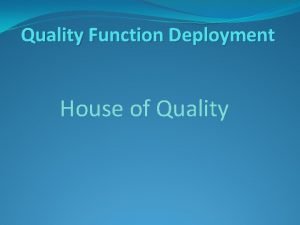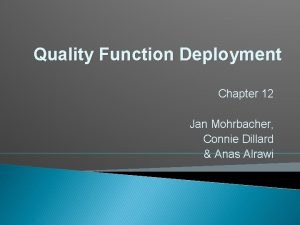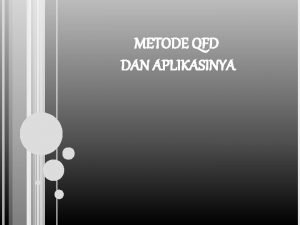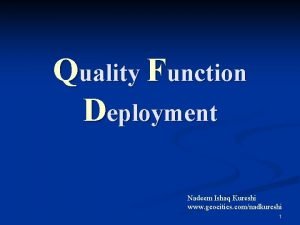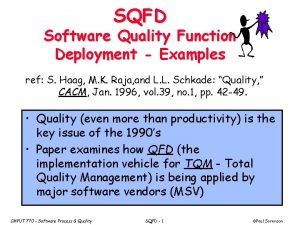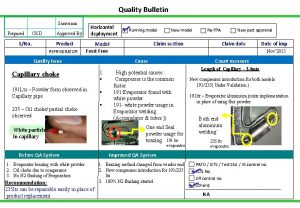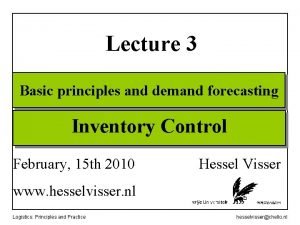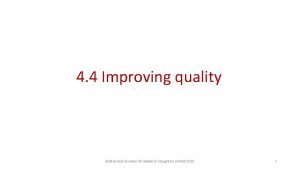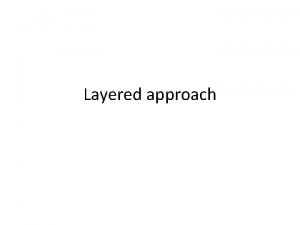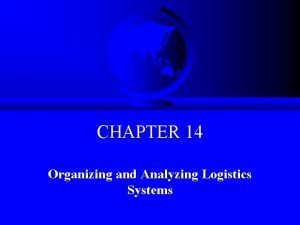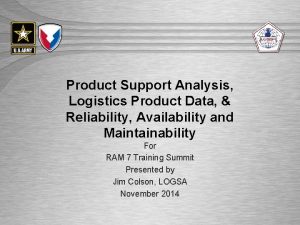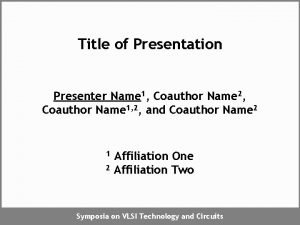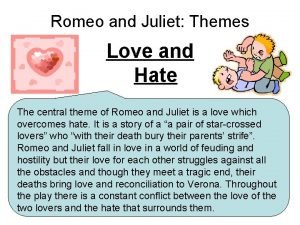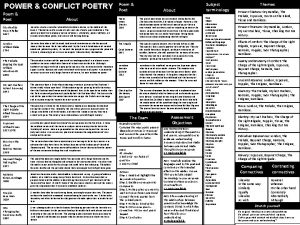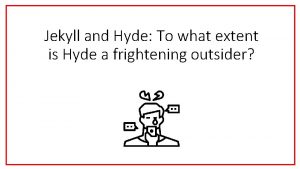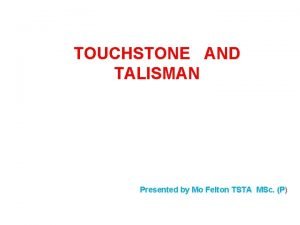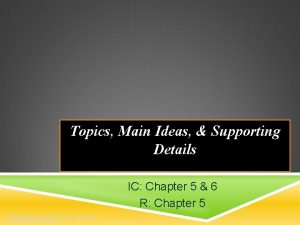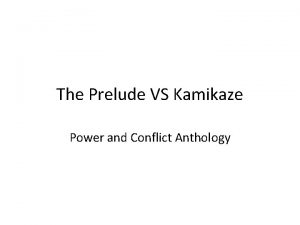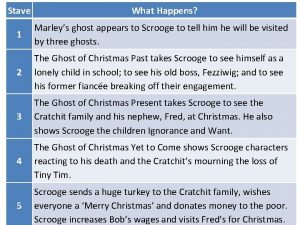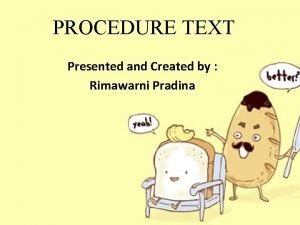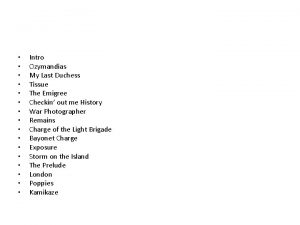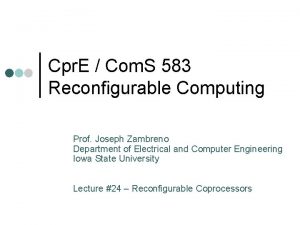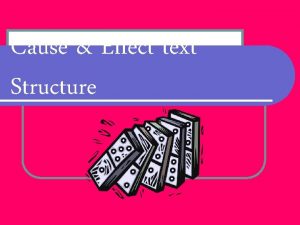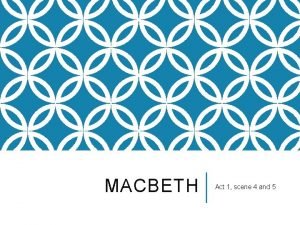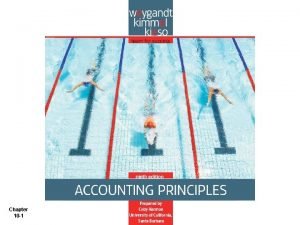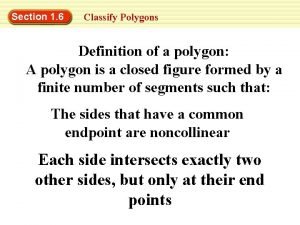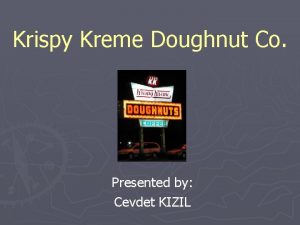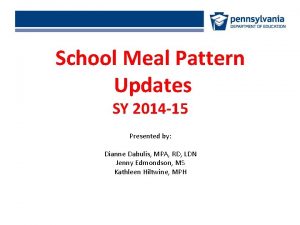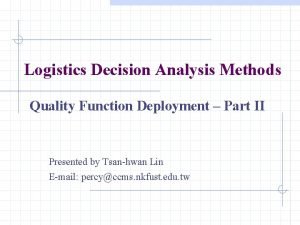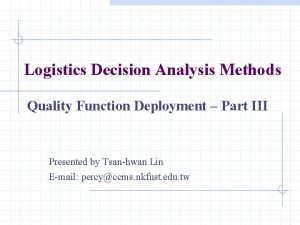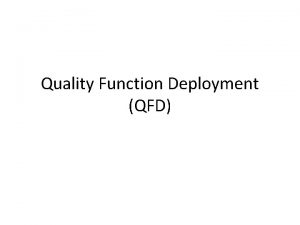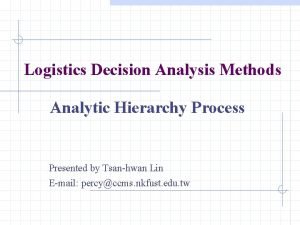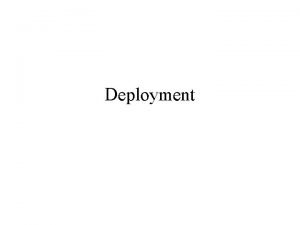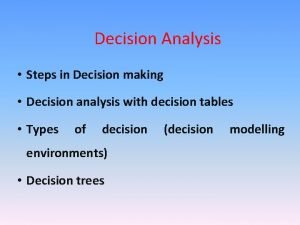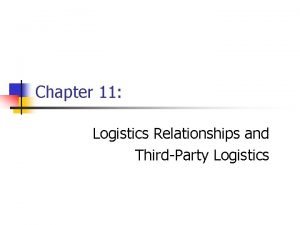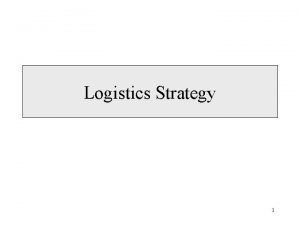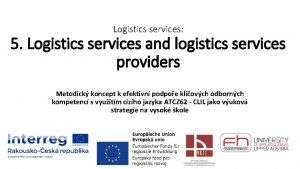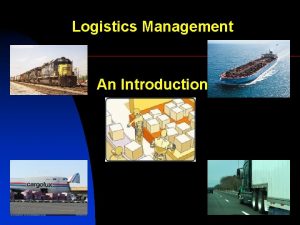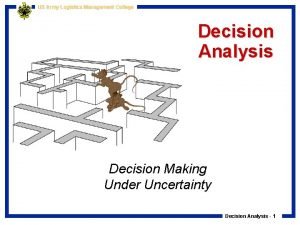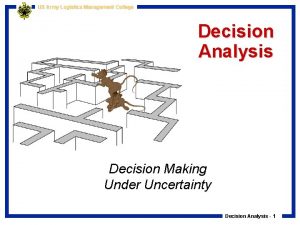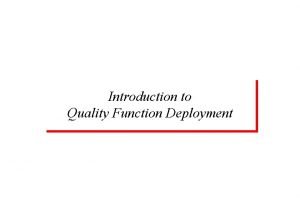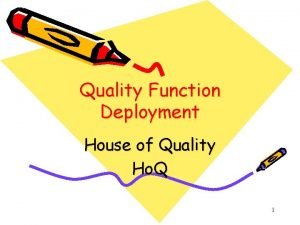Logistics Decision Analysis Methods Quality Function Deployment Presented




























































- Slides: 60

Logistics Decision Analysis Methods Quality Function Deployment Presented by Tsan-hwan Lin E-mail: percy@ccms. nkfust. edu. tw

Milestones for QFD Development - 1 Year/Date Event 1966 Japanese industry begins to formalize QFD concepts developed by Yoji Akao(赤尾洋二)(and by late Shigeru Mizuno ) 1972 Yoji Akao introduces QFD quality tables at Kobe Shipyards 1978 Dr. Shigeru Mizuno and Dr. Yoji Akao publish Development of the Quality Function (Japanese book on QFD) November, 1983 Akao and others introduce QFD at a U. S. workshop in Chicago, Illinois. One of the attendants is Henry Klein of Black and Decker. March, 1984 Professor Makabe of Tokyo Institute of Technology explains QFD to Don Clausing (a Xerox employee then, learning Robust Design methods of Genichi Taguchi. Don later joined faculty of MIT).

Milestones for QFD Development - 2 Year/Date Event March, 1984 Bob King (, the founder and executive director of GOAL/QPC, learned QFD from Henry Klein) begins offering a one-day course on QFD. 1987 Bernie Avishai, associate editor of Harvard Business Review, asks Don Clausing to write an article on QFD. Don invites John Hauser to co-author it. It is published in May-June 1988. 1987 GOAL/QPC publishes the first full-length book on QFD in U. S. : Better Designs in Half the Time. 1989 present Sponsorship of QFD symposium at Novi, Michigan

Quality Function Development Quality Function Deployment(QFD;品質機 能展開)is a method for structured planning and development that enables a development team to specify clearly the customer’s wants and needs(要求與需求), and then to evaluate each proposed product or service capability systematically in terms of its impact on meeting those needs.

Meaning of QFD The Japanese characters for QFD are, phonetically, n n n Hinshitsu Kino Tenkai quality; features; attributes; qualities function; mechanism deployment; diffusion; development; evolution

Basic QFD Process The QFD process involves constructing one or more matrices (sometimes called “quality table;品質表”). n n The first of these matrices is called the House of Quality (品質屋;HOQ). Beyond the HOQ, QFD optionally involves constructing additional matrices which further guide the detailed decisions that must be made throughout the product or service development process.

QFD - Revisit QFD is not just a prioritization tool, it is also a “deployment tool. ” n What we mean by “deployment” is that QFD helps us to start with the highest level of “Whats, ” generally the VOC, and to deploy, or translate, that voice into a new language that opens the way for appropriate action. QFD provides a repository for product planning information. n The repository is based on the structure of the QFD matrices. The matrices allow for entering (1) the VOC and all related quantitative information, (2) the Voice of Developer and all related quantitative information, and (3) the relationships between these voices.

Kano’s Model The Japanese TQM consultant Noriaki Kano, has provided us with a very useful model of customer satisfaction as it relates to product characteristics. Kano’s model divides product characteristics into three distinct categories, each of which affects customers in a different way. n n n Dissatisfiers, also known as “must-be, ” “basic, ” or “expected” characteristics. Satisfiers, also known as “one-dimensional” or “straightline”characteristics. Delighters, also known as “attractive” or “exciting” characteristics.

Kano’s Model Diagram Customer satisfaction + Delighters Actual performance 0% 100% Satisfiers Dissatisfiers _

Market Dynamics of Dissatisfiers, Satisfiers, and Delighters often create new markets or new market segments, thereby giving their creators a temporary competitive advantage. n After awhile, many satisfiers become “expected quality, ” and customers assume these satisfiers will be included in the product. n Once the novelty of a delighter wears off, and the competition includes the delighter or some equivalent solution into their own products, customers begin to expect (desire) the delighter, since it’s available in all competing products. In other words, delighters become demoted to satisfiers. When this happens, the satisfiers have become demoted to dissatisfers. This migration of quality attributes happens all the time with all products. n n In order to remain competitive, the product or service developer must continually search for new delighters, provide more satisfiers than anyone else, and see to it that no dissatisfiers reach the customer. QFD is an excellent planning tool for sorting out these different qualities and for managing them.

Lesson from Kano’s Model First, all customer satisfaction attributes are not equal. n Second, the old product quality strategy of responding to customer complaints can now be seen to be inadequate. n Not only are some more important to the customer than others, but some are important to the customer in different ways than others. (Dissatisfiers => deduct; Satisfiers => linearly add; Delighters => extra points) A quality strategy based solely on removing dissatisfiers can never result in satisfied customers. A strategy which will lead to customer satisfaction and to a leadership product or service must be far more proactive. n n n The strategy must be based on a deliberate policy of seeking out customers and potential customers to discover and characterize their needs, both met and unmet. (Finding needs) It must aim at breaking old thought patterns and finding creative ways of meeting those needs and exceeding customers’ expectations. (Designing responses) Finally, it must be based on a clear, reliable way of estimating the efficacy of each potential method for meeting customer needs, so that the best way can be exploited. (Evaluating efficiency)

Seven Management and Planning Tools QFD uses certain problem-solving and planning tools drawn from a set called the “Seven Management and Planning Tools. ” n In the late seventies, a book appeared in Japan, published by the Japanese Union of Scientists and Engineers (JUSE), entitles The Seven New Tools. u n n These tools were intended to provide a level of problem solving power in the conceptual domain equivalent to the power of the Seven Basic Tools in the process improvement domain. (新品管七大手法 vs. 品管七大手法) The Seven New Tools are usually called the Seven Management and Planning Tools in the United States. Tools which are the mainstays of QFD are: Affinity Diagram Matrix Diagram n Tree Diagram Prioritization Matrix Tools which are not directly required for QFD, but are helpful, are: Interrelationship Diagram Matrix Data Analysis Process Decision Program Chart Arrow Diagram

Overview of the HOQ There are two reasons to focus so much on the HOQ (House of Quality): n n First, it contains many of the features we will see in other parts of QFD, so once we have studied it, the remaining QFD matrices and charts will be fairly easy to understand. Second, a mandatory basic introduction to QFD must include the HOQ, and once mastered, the HOQ leads fairly naturally to various extensions. (even for many teams choose not to use the rest of QFD) The HOQ contains many sections or rooms, each of which can and should be customized by the development team to meet its needs. n è While various sequences for working on the sections each have advantages, the team must consciously choose a sequence and plan its work accordingly. Every aspect (including sequence, content, and methodology applied) of QFD is a candidate for modification or omission according to the needs of the development team.

Tour of the HOQ The first section of the HOQ to be constructed will almost always be the Customer Needs/Benefits section. n Sections are also referred to as “rooms. ” Planning Matrix (also, Preplanning Matrix) The is often the second section to e constructed. The third section of the HOQ to complete is the Technical Response (also, Corporate Expectations) section. The fourth step is to complete the “Relationship” section of the HOQ. The fifth and sixth steps in completing the HOQ are Competitive Benchmarking and Target Setting. The seventh and usually final step in completing the HOQ is to fill in the Technical Correlations Matrix. n This part is also referred to as “roof. ”

Tour of the HOQ - 2 Technical Correlations Technical Response (Substitute Quality Characteristics) Customer Needs and Benefits Planning Matrix Technical Matrix Relationships Technical Response Priorities Competitive Technical Benchmarks Technical Targets

Q&A

The House of Quality - 1 HOQ displays (1) the customer’s wants and needs (Voice of Customer; VOC) along the left, and (2) the development team’s technical response to meeting those wants and needs along the top. Each of the labeled sections, A through E, is a structured, systematic expression of a product or process development team’s understanding of an aspect of the overall planning process for a new product, service, or process. n The lettering sequence suggests one logical sequence for filling the matrix.

The House of Quality - 2 E. Technical Correlations C. Technical Response A. D. B. Customer Relationships Planning Needs and (Impact of Technical Response Matrix on Customer Needs and (Market Research Benefits) F. Technical Matrix (Technical Response Priorities, Competitive Technical Benchmarks, Technical Targets) and Strategic Planning)

Customer Needs and Benefits Section A contains a structured list of customer wants and needs. n n The structure is usually determined by qualitative market research. The data is in the form of a tree diagram.

Planning Matrix Section B contains three main types of information: n n n Quantitative market data, indicating (1)the relative importance of the wants and needs to the customer, and (2) the customer’s satisfaction levels with the organization’s and its competition’s current offering (usually by survey). Strategic goal setting for the new product or service. Computations for rank ordering the customer wants and needs.

Technical Response Section C contains, in the organization’s technical language, a high-level description of the product or service they plan to develop. n Normally, this technical description is generated (deployed) from the customer’s wants and needs.

Relationships Section D contains the development team’s judgments of the strength of the relationship between (1) each element of their technical response and (2) each customer want and need.

Technical Correlations Section E contains the development team’s assessments of the implementation interrelationships between elements of the technical response.

Technical Matrix Section F contains three types of information: n n n The computed rank ordering of the technical responses, based on (1) the rank ordering of customer wants and needs from Section B and (2) the relationships in Section D. Comparative information on the competition’s technical performance. Technical performance targets.

Interrelated Matrices - 1 2. : “Hows” HOQ: “Hows” Matrix 3 3. : “Hows” Priorities 2. : “Hows” Matrix 2 HOQ: “Hows” Priorities HOQ: “Whats” House of Quality 3. : “Hows”

Interrelated Matrices - 2 The HOQ is constructed as discussed earlier. To link HOQ to Matrix 2, the development team places all, or the most important, of the HOQ “Hows” on the left of Matrix 2, and their priorities on the right of Matrix 2. n n n These HOQ “Hows” now become the “Whats” of Matrix 2, and their relative importance to the development team is what was determined in the HOQ. To achieve the Matrix 2 “Whats, ” the development team needs a new, more technical or more detailed set of “Hows, ” which they generate and put at the top of Matrix 2. As before, the team uses the weights of the Matrix 2 “Whats, ” and their estimates of the degree of relationship between the Matrix “Hows” and the Matrix “Whats, ” to arrive at weights or priorities for the Matrix 2 “Hows. ” Each matrix in the chain represents a more specific or more technical expression of the product or service.

Classical Model for QFD The following model mirrors the process of designing and manufacturing a product. n Some QFD matrix schemes involve as many as 30 matrices (that use the VOC priorities to plan multiple levels of design detail, Quality Improvement Plans, Process Planning, Manufacturing Equipment Planning, and various Value Engineering plans). Matrix House of Quality What Voice of the Customer How Technical Performance Measures Subsystem Design Matrix Technical Performance Measures Piece-Part Characteristics Piece-Part Design Matrix Piece-Part Characteristics Process Parameters Process Design Matrix Production Operations Process Parameters

Kano’s Model - Dissatisfiers A dissatisfier(不滿足因子)is a product characteristic that the customer takes for granted when it is presented, but that causes dissatisfaction when it is missing. n n n Dissatisfiers are things that customers don’t normally ask about, because they expect them to be taken care of. Dissatisfiers are the absence of “expected quality, ”(期待品質) in the sense that customers expect products to be essentially flawless, and if they are not, the customers are dissatisfied. Examples: scratches or blemishes on product surface, broken parts, missing instruction booklets, or missing features routinely supplied. If we deliver a product or service that has many dissatisfiers, customers will be extremely unhappy. However, if we eliminate them all, we won’t have achieved a very high level of customer satisfaction. Customer complaints(客戶抱怨)are a primary source of information on existing dissatisfiers in our current products.

Kano’s Model - Satisfiers A satisfier(滿足因子)is something that customers want in their products, and usually ask for. n n The more we provide of a satisfier, the happier customers will be. Satisfiers are sometimes called “desired quality” (需求品 質) because they represent the aspects of the product that define it for the customer. Examples: increased capacity, lower cost, higher reliability, greater speed, and easier use. Satisfiers are the attributes that tend to be easy to measure, and therefore they become the benchmarks used for competitive analysis.

Kano’s Model – Delighters (1) Delighters(取悅因子)are product attributes or features that are pleasant surprises to customers when they first encounter them. n n n However, if delighters are not present, customers will not be dissatisfied, since they will be unaware of what they are missing. Delighters are sometimes called “exciting quality”(令人興 奮品質)or “unexpected quality. ”(超乎預期品質) As with dissatisfiers, customers don’t tell us they want delighters, but for very different reasons. u Customers can’t expect “unexpected quality” by definition.

Kano’s Model – Delighters (2) n Each delighter is unique, and as a group there are no patterns. Some delighters are entire products that have created new markets (a typical consequence of building delighters into products). Examples: Sony Walkman; 3 M Post-it Note u Examples: “redial” button on telephone receiver; spare change holders/ soft drink holders in automobiles; one-touch recording button on some VCRs; graphic user interfaces (GUI) of some desktop computers u n n The needs that delighters fill are often called “latent” or “hidden” needs(潛在需求;隱藏需求), either because they cannot be explicitly identified or because customers don’t say that the needs are important to them. These hidden needs are sometimes intimately linked to customer’s perceptions of the limits of technology. u Examples: five-hour travel method from New York to San Francisco in 1840 => unimaginable (the existence of a airplane)

Kano’s Model – Delighters (3) n There is no clear method for discovering delighters that is guaranteed to work in all cases. u One of the disciplines that QFD helps us to maintain is to separate customer needs from technical solutions. u So, it is consistent with the intent of QFD to search first for customer needs (Part A in HOQ), and only afterwards for technical responses (Part C in HOQ) to those needs, including delighters.

新品管七大手法 KJ法(Affinity Diagram;親和圖) 系統圖(Tree Diagram;樹狀圖) 矩陣圖(Matrix Diagram) 優先次序矩陣(Prioritization Matrix) n 矩陣數據解析法(Matrix Data Analysis) 關連圖(Interrelationship Diagram) 過程決定計畫圖法(Process Decision Program Chart; PDPC) 箭頭圖(Arrow Diagram; Activity Network Diagram)

Affinity Diagram - 1 The Affinity Diagram provides for a hierarchical structuring of ideas. n n It is a powerful tool for organizing qualitative information (such as customer’s voice). The hierarchy is built from the bottom up, and the relationships between the ideas are based on the intuition of the team creating the diagram.

Affinity Diagram - 2 The (word processing) program is a pleasure to use Program is quick and responsive Can adjust the cursor to move as quickly as I’d like Enables me to find things in the document Commands are easy to know and use Know what an icon is going to do before I click on it Can customize the icon display so that it’s easy for me to use Clear relationship between menu commands and icons Able to execute common operations in a single step Can execute commands quickly Easy font management Offers lots of size, font, and design options Able to see what the fonts look like as I’m choosing them Can organize the listing of fonts to reflect the way I use them Everything stays neat and aligned when I change fonts

Tree Diagram - 1 The Tree Diagram, like the Affinity Diagram, is a hierarchical structure of ideas. n In contrast to the Affinity Diagram, which is built from the bottom up and is based on an intuitive feeling for how the ideas go together, the Tree Diagram is built from the top down and uses logic and analytical thought process. The difference between the two is the method of producing them, not their format. u Affinity Diagrams start with the raw data and end with a hierarchical structure (bottom up); Tree Diagrams start with a presumed structure and end up with a detailed elaboration of the structure (top down) u n The Tree Diagram usually starts with some already-existing structure, for example, the hierarchy created by the Affinity Diagram process. u The team then examines each level of the Tree Diagram, starting with the most abstract or highest level, and analyzes that level for completeness and correctness.

Tree Diagram - 2 Program is quick and responsive Can adjust the cursor to move as quickly as I’d like Enables me to find things in the document Know what an icon is going to do before I click on it The (word processing) program is a pleasure to use Commands are easy to know and use Can customize the icon display so that it’s easy for me to use Clear relationship between menu commands and icons Able to execute common operations in a single step Can execute commands quickly Offers lots of size, font, and design options Easy font management Able to see what the fonts look like as I’m choosing them Can organize the listing of fonts to reflect the way I use them Everything stays neat and aligned when I change fonts

Matrix Diagram - 1 A matrix is a rectangular diagram divided into horizontal rows and vertical columns. n n Where a row and a column intersect, we have a cell. The cell is uniquely associated with one and only one row-column pair. We list a range of comparable items along the left side of the matrix. Each of these comparable items is therefore associated with a row of the matrix. We list another range of items along the top and associate each of those with a column. Comparable items refer to items that are all attributes or facets of the same generic topic. u Examples: green, red, blue, and yellow => COLOR u n We can use each cell in the matrix to record some relationship between the item associated with the row and the item associated with the column.

Matrix Diagram - 2 The Matrix is a simple but powerful tool that lies at the heart of QFD. n Its versatility is heavily exploited throughout QFD. A B C D E F 1 2 3 4 5 6 7

Prioritization Matrix - 1 The prioritization Matrix is an extension of the Matrix Diagram. It allows us to judge the relative importance of columns of entries. n We can put many different things into the cells of a matrix.

Prioritization Matrix - 2 A B C D E F 1 2 3 4 5 6 7

品管七大手法 特性要因圖(Characteristics Diagram; Cause-and-Effect Diagram) 查檢表(Check Sheet) 柏拉圖(Pareto Diagram) 直方圖(Histogram) 散佈圖(Scatter Diagram) 管制圖(Control Chart) 層別法(Stratification) 流程圖(Flow Diagram)

HOQ: Customer Needs and Benefits The Customer’s Wants and Needs are normally derived from the actual words of the customer (Voice of the Customer; VOC). n n Once gathered, the customer phrases are developed into a hierarchy by means of the Affinity Diagram process, with the most detailed needs at the lowest level, and the more abstract needs in higher levels of the hierarchy. Most development teams collect the VOC from interviews, and then create the hierarchy of wants and needs themselves, although it is possible and desirable to have the customers strongly influence or completely determine the structure.

HOQ: Planning Matrix - 1 In Planning Matrix, the development team records its answers to a variety of marketing and product planning questions. The Planning Matrix calls for high-level product goal setting, based on the team’s interpretation of the market research. n The goal setting has the effect of combining the company’s business priorities with the customer’s priorities.

HOQ: Planning Matrix - 2 The specific information in the Planning Matrix is: n n n Importance to customer: How important is the need to the customer? (from market research) Current satisfaction performance: How well does the team’s current most similar product or service offering meet customers’ need? (from market research) Competitive satisfaction performance: How well does the competition’s current most similar product or service offering meet customers’ need? (from market research) Company goal: How well does the team want to meet customers’ needs for the product or service being planned? (team’s determination) Sales point: To what extent could meeting-a-need-well used as a sales point? (team’s determination) The answers to these questions combine to create a prioritization or rank ordering of the Customer Needs/Benefits.

HOQ: Planning Matrix - 3 One reason to fill in the Planning Matrix immediately after the Customer Needs/Benefits are completed is because once the Customer Needs/Benefits are prioritized, the QFD team may choose to restrict its analysis only to the highest ranking Customer Needs. (Efficiency) However, an advantage (of developing Planning Matrix after generation of the Technical Responses and even the Relationships) is that the team will be required to become extremely familiar with the customer needs in order to generate the Technical Responses. Hence, they will be much better prepared to do the goal setting and high-level analysis in the Planning Matrix when they get to it. (Variety and Dedication)

HOQ: Technical Response - 1 The Technical Response can be thought of as a set of product or process requirements, stated in the organization’s internal language. There a variety of different types of information that are placed here. The most common alternatives are, 1) 2) 3) n n Top-level solution – independent measures or metrics Product (or service) requirements Product (or service) features or capabilities Whichever type of information is chosen, we call it Substitute Quality Characteristics (SQC). Just as the Customer Needs/Benefits represents Voice of the Customer, the SQCs represent the Voice of the Developer.

HOQ: Technical Response - 2 Whether teams use measurements, requirements, or features as their SQCs depends on the design methodology of their organization. When there is a great deal of detail, the SQCs can be arranged hierarchically by means of Affinity Diagram process, followed by the Tree Diagram process. n n The higher the level, the smaller the Relationship section; the lower the level, the more detailed the analysis. This process is similar to that applied in Customer Needs/Benefits section.

HOQ: Relationship - 1 This is the largest section of the matrix (i. e. HOQ), and therefore represents the largest volume of work. This step use the Prioritization Matrix method. n n For each cell in the Relationship section, the team enters a value that reflects the extent to which the SQC (at the head of the column) contributes to meeting the Customer Needs/Benefits (to the left of the row). This value, along with the prioritization of the Customer Needs/Benefits, establishes the contribution of SQC to overall customer satisfaction. Once the contributions of all SQCs have been computed, the SQCs are essentially prioritized. n Those with greatest overall impact on customer satisfaction are most important. This fundamental result is one of the most important outcomes of using QFD.

HOQ: Relationship - 2 Some QFD teams abandon QFD at this point and use the priorities of the SQC to plan later stages of the development project. Other teams use the prioritization of the SQC to provide guidance about further product planning activities. n These activities are Competitive Benchmarking and Target Setting.

HOQ: Competitive Benchmarking and Target Setting occupy the bottom two lines of the HOQ. Competitive Benchmarks and Targets are normally expressed in language compatible with the language of the SQC.

HOQ: Technical Correlations Matrix This matrix is used to record the way in which SQCs either support or impede each other. This information helps QFD team to identify design bottlenecks, and it helps them to identify key communication paths among designers.

Backup Materials

Cause-and-Effect Diagram : Paint Peeling Material Work Method EFFECT House Paint Peeling Equipment Environment

Check Sheet : Swimming Pool Mgt. Pool Chemical Test (add if needed) Add Water (if needed) Check Temperature Sweep and Hose Off Deck Vacuum Pool Mon. 7. 6 300 gal 78 Tue. Wed

Pareto Diagram : Customer Complaints - Determine the Vital Few 70 49% 60 50 40 26% 30 20 10 7% 6% 5% 0 Complaints 3% 4%

Histogram : Defective Parts 14 12 Frequency 10 8 6 4 2 0 0 1 2 3 4 Number Nonconforming 5

Gas Mileage (Miles per Gallon) Scatter Diagram : Gas Mileage 36 34 32 30 28 26 24 22 30 35 40 45 50 55 Speed (Miles per Hour) 60 65

Control Chart : Gauge Diameter

Process Flow Diagram : Order Taking No Hold Telephone Fax Log In Credit Check OK Letter Inventory Check Schedule Production Contract Review
 Quality function deployment diagram
Quality function deployment diagram Who conceptualized quality function deployment?
Who conceptualized quality function deployment? Apa itu metode qfd
Apa itu metode qfd What is qfd
What is qfd Quality function deployment
Quality function deployment Qfd examples
Qfd examples No decision snap decision responsible decision
No decision snap decision responsible decision Financial management process
Financial management process Horizontal deployment in quality
Horizontal deployment in quality Logistics forecasting methods
Logistics forecasting methods Direct wax pattern
Direct wax pattern Decision table and decision tree examples
Decision table and decision tree examples Quality business a level
Quality business a level Quality control methods for medicinal plant materials
Quality control methods for medicinal plant materials Quality methods and tools
Quality methods and tools Explain quality control
Explain quality control Logistics system analysis
Logistics system analysis Logistics product data software
Logistics product data software Quality assurance vs quality control
Quality assurance vs quality control Plan quality management pmp
Plan quality management pmp Quality metrics pmp
Quality metrics pmp Define seminar in nursing management
Define seminar in nursing management Compliance vs quality
Compliance vs quality Quality assurance concepts
Quality assurance concepts Management gurus and their contributions
Management gurus and their contributions Crosby quality is free
Crosby quality is free Old quality vs new quality
Old quality vs new quality It is a headline presented in two or more lines
It is a headline presented in two or more lines Presenter title
Presenter title Setting of dr jekyll and mr hyde
Setting of dr jekyll and mr hyde Theme of romeo and juliet
Theme of romeo and juliet Which fact is mentioned in both passages
Which fact is mentioned in both passages Presenters name
Presenters name How is power presented in ozymandias and london
How is power presented in ozymandias and london Cognitive learning theory by jerome bruner
Cognitive learning theory by jerome bruner Hyde as an outsider
Hyde as an outsider Talisman presented
Talisman presented Topic main idea and supporting details examples
Topic main idea and supporting details examples Kamikaze power of nature
Kamikaze power of nature Design process
Design process Bob cratchit quotes
Bob cratchit quotes Procedure text structure
Procedure text structure Introduction to conic sections
Introduction to conic sections My last duchess and ozymandias
My last duchess and ozymandias Prism is presented with
Prism is presented with Cause and effect structure
Cause and effect structure What type of technical drawing is presented
What type of technical drawing is presented Generic structure of spoof text
Generic structure of spoof text Proudly supported by
Proudly supported by Act 5 macbeth summary
Act 5 macbeth summary Lady macbeth soliloquy act 1 scene 5
Lady macbeth soliloquy act 1 scene 5 Depletion journal entry
Depletion journal entry As presented below
As presented below Type of polygon
Type of polygon Krispy kreme vs dunkin donuts
Krispy kreme vs dunkin donuts Benjamin zephaniah young and dyslexic
Benjamin zephaniah young and dyslexic Presented sy
Presented sy The kitchen presented by
The kitchen presented by Professionally presented
Professionally presented Family feud presented by
Family feud presented by Madtshirt music
Madtshirt music
